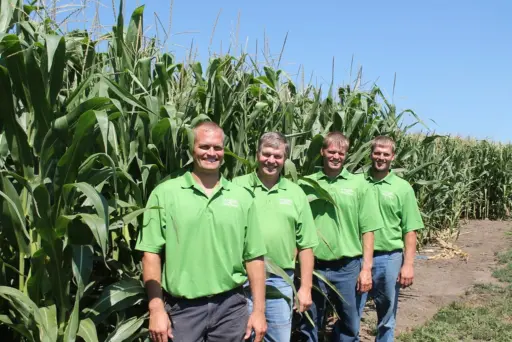Lee Maassen and his three sons are well versed in the importance of sustainability and conservation. Their heritage of farming started in the 1920s with the mission: “To be good caretakers of the people, land, and animals God has blessed us with.”
On the farm, the family considers their greatest achievement to be the increased erosion control and nutrient management they have developed over the last one hundred years. Northwest Iowa, where the Maassen farm is located, is an agricultural area with many other nearby farms. This was all the more reason for the Maassens to prioritize sustainability, and as Lee puts it, “The soil is our 401k—we want it to stay and grow, not deplete. Without the land, there is no farm for the next generation.” In order to increase their sustainable practices and maintain the farm for the next generations, the Maassens implemented successful cover crop plans using rye and alfalfa to minimize erosion off of their fields into the two creeks that run through their farm, as well as improve the health of their soil. In addition, they installed a four-cell system to reclaim and recycle the sand used as bedding for their cows in 2014.

They manage their cropland by splitting their 1,500 acres of farmland into a grid. This grid divides the land into two-acre sections so the Maassens can easily conduct annual soil samples after the fall corn harvest. This test tells them the specific nutrient mix needed for this section next year. Then, they analyze the manure from the cows prior to applying it on the fields. Every three years, the Maassens conduct a more detailed soil sample test to monitor how organic matter breaks down into the soil, providing them with data to adjust and fine-tune their nutrient management plans.
By implementing a rye and alfalfa cover crop plan, the Maassens are not only protecting their soil but growing a primary feed source for their cattle. Over the years, they have increased the use of cover crops on their acreage. Prioritizing sustainability has allowed the farm to grow, as well. When Lee began farming with his father, the farm had just 125 cows. Today, largely in thanks to the conservation efforts in place on the farm, they’ve increased to 1,750 on the same amount of land, all while keeping milk production at their goal of 28,000 pounds per cow and on track to meet their 30,000-pound goal in the coming years.
As the Maassens monitor their practices and incorporate new research and technologies, they’ve seen excellent results. By using cover crops, they can harvest year-round, with 95% of the crops they grow being harvested as forage. They have also seen an increase in soil organic matter from 3.5% to 5% since the start of cover crop usage in 2006. This provides a high-quality feed source for their animals that has boosted production and realized dramatic annual savings from not needing to purchase feed for their herd.
The Maassens’ leadership in sustainability has not gone unnoticed. In 2014, the dairy was selected to be part of a five-year project by the Iowa Department of Ag and Land Stewardship to showcase agronomic farm practices. In 2016, they were awarded the Iowa Venture Award by the Iowa Area Development Group, recognizing their innovation and entrepreneurial leadership. In 2016, they hosted an open house attended by 1,700 community members as well as Gov. Terry Branstad of Iowa. Later that year, they hosted an open house at their cover crop test plot in cooperation with the Farmers Co-Op Society of Sioux Center. The Maassens regularly host students of all ages and offer virtual tours of the farm through the Siouxland Ag in the Classroom program. Lee and his sons continue to serve the dairy industry through leadership on numerous boards and prioritize sharing their dairy story with consumers through social media and local events.
By prioritizing conservation on their own farm, the Maassens have become leaders in the dairy industry and their replicable model is encouraging other farms to improve their conservation efforts to make the future of dairy more sustainable.